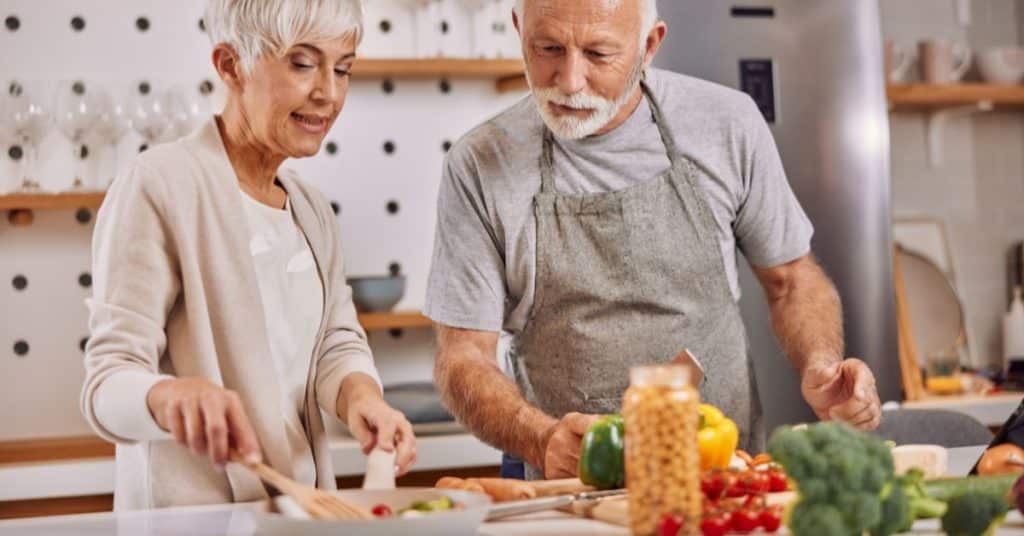Choosing a plant-based lifestyle is a huge step toward improving your health. Besides avoiding meat and dairy, eliminating oil is an essential component of a truly healthy diet. That’s why these plant-based tips for oil-free cooking are instrumental in maintaining and regaining health.
Surprising Nutritional Facts About Oil
- Gram-for-gram, oil has the same number of calories as beef fat.
- Coconut oil is 90% saturated fat, and lard is 40%.
- One tablespoon of oil has 120 calories and 14 grams of fat.
- A 130 lb woman would have to jog approximately 1.2 miles to burn off 1 tablespoon of oil.
- Within hours of ingesting oil—olive oil, corn oil, palm oil, etc.—arteries stiffen and their ability to dilate is impaired.[1]
Keep in mind that a plant-based diet does not mean a fat-free diet. Our bodies need dietary fat to function properly, and plants have all we need. Even broccoli, kale, beans, and quinoa have fat in small amounts.[2]
Learning to Cook Without Oil
At first it might seem a little crazy or scary to think of cooking without oil. Thankfully, learning to cook delicious oil-free recipes is not difficult. It might take a little practice to get things just right, but soon you’ll wonder how you ever tolerated the greasy taste and texture of oil-drenched foods!
Choosing the Right Cookware
Consider investing in some non-stick cookware. Though there is an initial cost, if taken care of properly, it will last forever. Some good-quality options are heavy-bottomed stainless steel pans, enamel-coated cast iron, or ceramic titanium pans. Be sure to hand-wash so the coating doesn’t wear off prematurely.
Silicone ovenware is great for easy release when roasting vegetables or baking and preparing oil-free desserts. Parchment paper is also a great option to line baking sheets and casserole dishes.
How to Replace Oil Depending on the Cooking Method:
- Sautéing and stir-frying—Believe it or not, when sautéing vegetables, water and broth do just as well as oil. The trick is to use small amounts, adding just 1 to 2 tablespoons at a time. Do this as often as needed to cook and brown the food. Remember to keep the veggies moving so they don’t burn. This is a short video clip showing how easy it can be: Cooking Without Oil.
- Baking— Making moist and delicious cookies, cakes, and other oil-free baked goods is actually quite easy. Some of my favorite substitutes include applesauce, mashed bananas, and puréed dates or pumpkin. In my Glazed Carrot Cake, I use both applesauce and banana to keep it moist, and the results are deliciously amazing!
- Roasting—Vegetables will brown on their own in the oven if you cook them low and slow. I like to lightly mist vegetables with water or veggie broth using a bottle sprayer, then sprinkle with spices and herbs for seasoning before roasting. For something super crispy like French fries or zucchini chips, finish the last few minutes by popping them under the broiler. Make sure to use parchment paper or a silicone baking sheet to prevent sticking.
- Deep Frying Alternatives—There is a secret weapon for achieving that extra crispy texture without using oil. It’s called an air fryer. Though this is not a required piece of equipment for a plant-based kitchen, I will say that I absolutely love mine. Some of the recipes I have been able to make are Asparagus, Mushroom, and Tofu Tempura, French fries, and more. I am happy to have all those crispy fried foods back in my life, only this time, they have zero oil and won’t be clogging my arteries or causing inflammation.
Once you try out some of these cooking techniques, it will become apparent how easy oil-free cooking can be. The food tastes delicious, and your arteries will thank you!
References
- http://ucdintegrativemedicine.com/2016/05/why-you-should-opt-out-of-olive-oil/#gs.Ao7vpMY
- https://nutritionstudies.org/fat-plant-based-diets/

